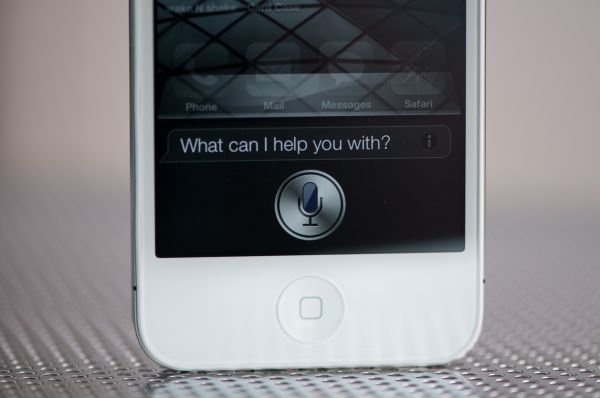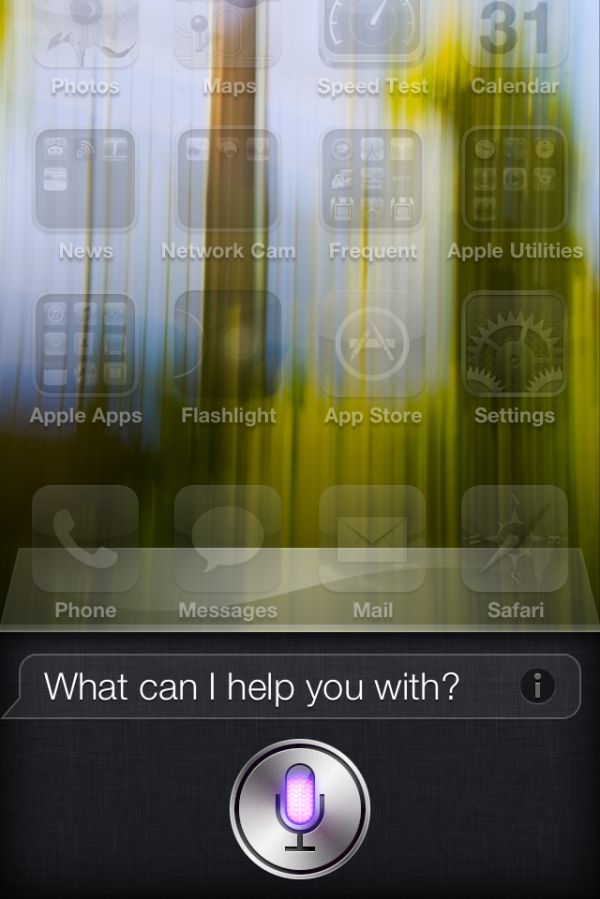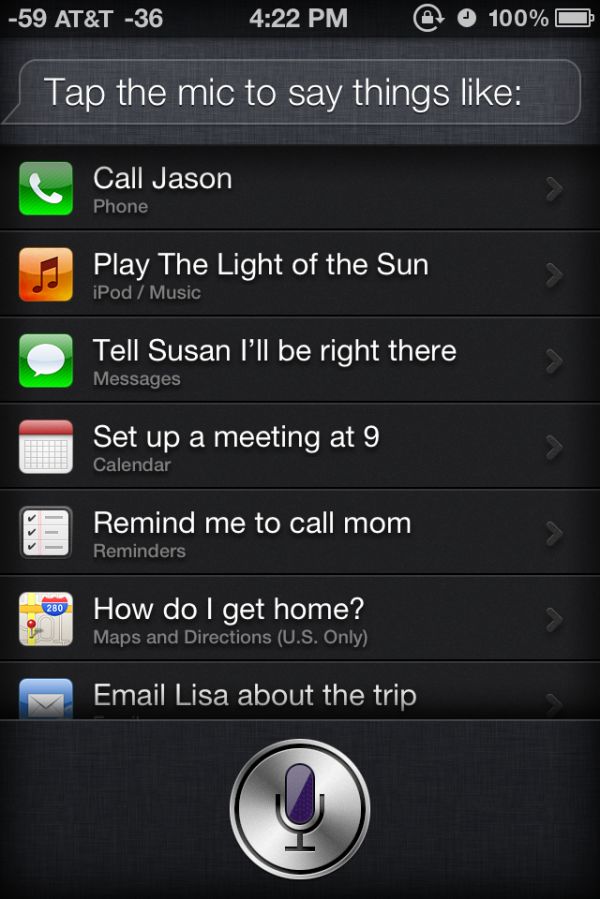Apple iPhone 4S: Thoroughly Reviewed
by Anand Lal Shimpi & Brian Klug on October 31, 2011 7:45 PM EST- Posted in
- Smartphones
- Apple
- Mobile
- iPhone
- iPhone 4S
Siri
Apple can credit much of its success to not only delivering good hardware, but using the hardware to develop new software experiences. With the 4S and iOS 5, most of the software experiences are available on older hardware - the sole exception being Siri.
The expectation that Apple will always deliver more than just a hardware upgrade is likely what made Siri a 4S exclusive (that and controlling the rollout as to not overly burden Apple's servers). The work carried out on the phone itself is minimal compared to what’s done server-side. A quick look at CPU utilization while running a simple Siri query (how many meters are in a mile) reveals the most stressful part of the process is animating the results on the screen. The display process is multithreaded but even then peak usage rarely steps above a single CPU core, in other words - this could have been done on the 4.
Siri is the logical next step from after the existing voice engine on the iPhone 4, which I doubt many people used on a day to day basis. Functionality was limited to a small laundry list of operations, and if you wandered outside the confines of those voice commands, you were left out of luck. I can count the number of times I did anything with the iPhone 4 voice commands on one hand.
Siri originally started as a standalone application, where it initially impressed with the ability to take a conversational approach to voice commands. Apple quickly acquired Siri, built it into iOS 5, and enabled the feature on just the iPhone 4S. At present, the feature only works for English (US, UK, Australia), French, and German, though in 2012 the language engine will also be compatible with Japanese, Chinese, Korean, Italian, and Spanish.
Hold the phone up to your head when not in a call, or long press the home button (which was the previous voice command action) and you’ll get Siri’s purple microphone and a circle button. If you’re familiar with Android’s voice dialogs, this visualization is pretty similar, though the functionality is very different.
Siri also works with bluetooth headsets and normal headsets, including the Apple-supplied button plus microphone earbuds. Normally Siri doesn’t read text messages or emails, but if you have a headset, it then reads everything back to you and becomes a much more powerful hands-free tool. Hold down the action button on a bluetooth earpiece or on the Apple earbud cable, and it will toggle Siri mode the same as holding the home button down. Bluetooth functionality works pretty well, though there’s added latency each time the earpiece audio link is established and torn down that can be unnerving.
Siri leverages Yelp for businesses/restaurants and Wolfram Alpha for any queries that require computation. It is interesting to think of Siri as Apple’s foray into search. Siri isn’t designed to monetize search, but any queries run through Siri definitely don’t line Google’s pockets. Given how much Google depends on search for its revenues and the growth of its businesses, Siri may be viewed as a competitive threat. Perhaps that’s why we don’t see Siri using Google for search?
There are two components to every Siri interaction: your query, and the results it returns. Where Siri is truly impressive is in its ability to understand your queries. You can ask it to tell you the closest Italian restaurants, or just utter the phrase “I want cake” and get a list of options in the area. For the former, Siri just looks for restaurants classified as Italian, for the latter it looks for restaurants whose Yelp reviews mention the word cake. Siri’s ability to dissect and handle the query is impressive, unfortunately its usefulness is gated by how active Yelp users are in your area. Yelp use in Raleigh is disappointing overall, which in turn hurts Siri’s ability to recommend what I’m looking for.


When it works, it works very well. There happen to be a lot of burger options where I live and simply asking Siri “what’s the best burger joint” returned a fairly accurate ranking of my options. The same goes for pizza, but my cake query didn’t really give me useful results either in Raleigh or Durham. Siri is only as smart as the databases that it relies on, and unfortunately simply looking for reviews that mention cake isn’t the best way to direct you to sugary goodness.


The computation aspect of Siri is pretty useful. You can ask Siri simple conversion questions like “how many quarts are in a gallon” or something more complex like “how much is a 15% tip for $247 for five people”. In the case of the latter you’ll get the total tip amount, the per-person share as well as other tip amounts (e.g. 10%, 20%). Take it one step further and ask Siri to tell you when it’s customary to tip and you quickly run into a wall. In this case it’s not the data but Siri’s awareness of the question that’s limiting you.


Given how frequently I’m in meetings, one of the most useful aspects of Siri to me personally is its ability to schedule meetings. I can tell Siri to schedule a meeting with AMD at 2PM Pacific and it’ll offer to create the appointment in my calendar for me. If there’s a conflict, Siri offers resolution options. Combine that with seamless calendar syncing via iCloud and you’ve got a pretty powerful tool. Siri also handles US time zones very well. As you may have gathered from the line above, I can tell Siri to schedule a meeting in a different time zone without having to do the conversion myself. The time zone support breaks down once you go beyond the US unfortunately.

Siri is similarly great for reminders. Using iOS 5’s location based triggers and by simply giving Siri some information ahead of time (e.g. telling it where home and work are in your address book), you can have Siri remind you to buy milk when you leave work or buy a cat when you leave home.
Siri’s voice recognition engine works pretty well out of the box, but also learns individual voice characteristics and dialects on a larger scale. This individually trained language data can optionally be reset as well by just toggling Siri off and back on. I trained Siri for about a week, reset the data, and went through a few commands - it’s obvious that it does tailor a voice profile after a while.
Siri is surprisingly good at following along in conversations, but ultimately it’s still limited to a certain set of tasks, though the list is pretty big. Things like emailing a contact, sending text messages, responding to messages, setting alarms, reminders, and appointments, playing music (based on artist, album, or title), looking basic things up, and then features that are enabled through ties into Yelp and WolframAlpha. Much of what I ask Siri that isn’t an obvious phone function (text, call, email) ends up being directed into a Yelp search, and the depth of interesting redirects here are impressive - everything from telling Siri you’ve soiled yourself (which sends you clothing stores), that you need drugs (which finds addiction treatment centers) to specific things like wanting a certain genre of food nearby. It’s clear that the team responsible for Siri had a lot of fun, and by now the number of interesting easter eggs have been pretty well documented all over the web.



















199 Comments
View All Comments
Davabled - Monday, October 31, 2011 - link
With Field test enabled, do numbers closer to zero indicate a better connection? (I'm referring to the numbers that replace the bars in the upper left corner)Anand Lal Shimpi - Monday, October 31, 2011 - link
Correct :)Take care,
Anand
Formul - Monday, October 31, 2011 - link
why the huge drop from iPad 2 to iPhone 4S in the GL benchmark pro? its only about 30% performance .... any explanation?Anand Lal Shimpi - Monday, October 31, 2011 - link
Because the number was incorrect :-P Fixed now :)Take care,
Anand
ZebuluniteX - Monday, October 31, 2011 - link
Great review as always Anand!In addition to the GL benchmark pro results Formul mentioned, I was also surprised to see the Motorola Droid RAZR for some reason do far better than other Gingerbread-based Android smartphones. It is listed as using different version of Android (2.3.5 vs 2.3.4 or older), but given that very similar results were shown between the iPhone 4S and Honeycomb-running Galaxy Tab 8.9 in your 'iPhone 4S Preliminary Benchmarks' article (where the 4S was a bit slower than the Galaxy Tab in SunSpider, and marginally faster in BrowserMark), I'm guess those are just mislabeled Galaxy Tab results. Is that the case?
Anand Lal Shimpi - Monday, October 31, 2011 - link
Thank you - be sure to thank Brian Klug as well, he really did the bulk of the heavy lifting here. I just popped in to talk about silicon and battery life.The RAZR numbers are what we ran at the RAZR announcement: http://www.anandtech.com/show/4981/motorola-droid-...
The improvement is likely due to an updated browser from Motorola. I included those numbers effectively as a placeholder until Ice Cream Sandwich arrives :)
Take care,
Anand
ZebuluniteX - Tuesday, November 1, 2011 - link
Ah, thanks for the clarification, I missed that article. Hmm, that's interesting that, apparently, Motorola "ported" Honeycomb or Ice Cream Sandwich's browser optimizations to Gingerbread (or at least I assume that's what happened)...I'm in the market for a smartphone, and while I was leaning towards the 4S since I already am in the Apple ecosystem via an iPod Touch 2G, before pulling the trigger I wanted to read the Anandtech take on it. The review was excellent as always - thanks again to both you and Brian!
Formul - Monday, October 31, 2011 - link
that was fast! i knew something was not right as there was no mention of this in the text :-)thanks for another great review, keep up the good work! :-)
zanon - Monday, October 31, 2011 - link
The article wrote "The expectation that Apple will always deliver more than just a hardware upgrade is likely what made Siri a 4S exclusive."While only time will tell for sure, it seems quite possible that graduated ramp up had a bigger role to play here. As you say, most of the heavy duty lifting for Siri is going on server-side, and in turn local processing needs aren't too bad. However, the natural flip side of that of course is that the server-side infrastructure is required for the service to work at all, and resources aren't unlimited there either. Even with it limited purely to 4S users, Siri still had some availability problems in the first few days as millions activated and tried to user it simultaneously. It's not hard to imagine what would have happened if every single one of the tens of millions able to upgrade to iOS 5 *also* tried to start using it immediately. Apple has built a huge data center and that's all well and good, but nothing substitutes for actual working experience when it comes to massive software services.
By limiting the initial rollout, Apple can do performance profiling, get an idea of average loads after initial "let's try it" dies down, and so forth. Staggering a rollout also means being able to plan for the general load rather then suffering the classic and well known double-bind of
A) Building for a peak load, and ending up being left with a lot of extraneous hardware that barely gets used.
B) Building for the average, then suffering from embarrassing and headline generating outages for a week or two.
It's true they could just decide to keep it 4S only, but given they are still selling the iPhone 4, and probably make plenty of profit on that now very mature device, I think there is a decent chance they'll roll it out to a wider audience down the road.
Also, a few typos:
Page 2:
I think the phrase is "pretty much par for the *course* for Apple..." rather then "par for the case".
Pg 9, WiFi:
"...newest WLAN, Bluetooth, and FM *cobo* chip" should I think be "combo".
Pg 15:
...4S, without a (big blank, presumably some sentence was supposed to go here?)
Pg 16:
"aren't simply *academical*" should be "academic".
Again, great review, thank you.
Anand Lal Shimpi - Monday, October 31, 2011 - link
That's a very good point, I will add it to the discussion. The sinister view is to assume Apple did it to differentiate, the balanced view takes into account infrastructure, which is exactly what you did here :)And thanks for the corrections :)